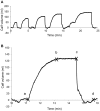Altered Venous Function during Long-Duration Spaceflights
- PMID: 28955249
- PMCID: PMC5600926
- DOI: 10.3389/fphys.2017.00694
Altered Venous Function during Long-Duration Spaceflights
Abstract
Aims: Venous adaptation to microgravity, associated with cardiovascular deconditioning, may contribute to orthostatic intolerance following spaceflight. The aim of this study was to analyze the main parameters of venous hemodynamics with long-duration spaceflight. Methods: Venous plethysmography was performed on 24 cosmonauts before, during, and after spaceflights aboard the International Space Station. Venous plethysmography assessed venous filling and emptying functions as well as microvascular filtration, in response to different levels of venous occlusion pressure. Calf volume was assessed using calf circumference measurements. Results: Calf volume decreased during spaceflight from 2.3 ± 0.3 to 1.7 ± 0.2 L (p < 0.001), and recovered after it (2.3 ± 0.3 L). Venous compliance, determined as the relationship between occlusion pressure and the change in venous volume, increased during spaceflight from 0.090 ± 0.005 to 0.120 ± 0.007 (p < 0.01) and recovered 8 days after landing (0.071 ± 0.005, arbitrary units). The index of venous emptying rate decreased during spaceflight from -0.004 ± 0.022 to -0.212 ± 0.033 (p < 0.001, arbitrary units). The index of vascular microfiltration increased during spaceflight from 6.1 ± 1.8 to 10.6 ± 7.9 (p < 0.05, arbitrary units). Conclusion: This study demonstrated that overall venous function is changed during spaceflight. In future, venous function should be considered when developing countermeasures to prevent cardiovascular deconditioning and orthostatic intolerance with long-duration spaceflight.
Keywords: blood volume; cardiovascular deconditioning; microgravity; venous plethysmography.
Figures



Similar articles
-
Spacelab Life Sciences flight experiments: an integrated approach to the study of cardiovascular deconditioning and orthostatic hypotension.Acta Astronaut. 1987;15(5):291-4. doi: 10.1016/0094-5765(87)90074-9. Acta Astronaut. 1987. PMID: 11538833 Review.
-
Effects of spaceflight on human calf hemodynamics.J Appl Physiol (1985). 2001 Apr;90(4):1552-8. doi: 10.1152/jappl.2001.90.4.1552. J Appl Physiol (1985). 2001. PMID: 11247959
-
Regulation of body fluid volume and electrolyte concentrations in spaceflight.Adv Space Biol Med. 1997;6:123-65. doi: 10.1016/s1569-2574(08)60081-7. Adv Space Biol Med. 1997. PMID: 9048137 Review.
-
Cardiac, arterial and venous adaptation to weightlessness during 6-month MIR spaceflights with and without thigh cuffs (bracelets).Eur J Appl Physiol. 2000 Mar;81(5):384-90. doi: 10.1007/s004210050058. Eur J Appl Physiol. 2000. PMID: 10751099 Clinical Trial.
-
Autonomic cardiovascular and respiratory control during prolonged spaceflights aboard the International Space Station.J Appl Physiol (1985). 2007 Jul;103(1):156-61. doi: 10.1152/japplphysiol.00137.2007. Epub 2007 Apr 19. J Appl Physiol (1985). 2007. PMID: 17446414
Cited by
-
Computational modeling of orthostatic intolerance for travel to Mars.NPJ Microgravity. 2022 Aug 9;8(1):34. doi: 10.1038/s41526-022-00219-2. NPJ Microgravity. 2022. PMID: 35945233 Free PMC article.
-
Comprehensive assessment of physiological responses in women during the ESA dry immersion VIVALDI microgravity simulation.Nat Commun. 2023 Oct 9;14(1):6311. doi: 10.1038/s41467-023-41990-4. Nat Commun. 2023. PMID: 37813884 Free PMC article.
-
Vascular and Microvascular Dysfunction Induced by Microgravity and Its Analogs in Humans: Mechanisms and Countermeasures.Front Physiol. 2020 Aug 20;11:952. doi: 10.3389/fphys.2020.00952. eCollection 2020. Front Physiol. 2020. PMID: 32973543 Free PMC article. Review.
-
Effects of weightlessness on the cardiovascular system: a systematic review and meta-analysis.Front Physiol. 2024 Jul 26;15:1438089. doi: 10.3389/fphys.2024.1438089. eCollection 2024. Front Physiol. 2024. PMID: 39129756 Free PMC article.
References
-
- Arbeille P., Fomina G., Roumy J., Alferova I., Tobal N., Herault S. (2001). Adaptation of the left heart, cerebral and femoral arteries, and jugular and femoral veins during short- and long-term head-down tilt and spaceflights. Eur. J. Appl. Physiol. 86, 157–168. 10.1007/s004210100473 - DOI - PubMed
-
- Arbeille P., Provost R., Zuj K., Vincent N. (2015). Measurements of jugular, portal, femoral, and calf vein cross-sectional area for the assessment of venous blood redistribution with long duration spaceflight (Vessel Imaging Experiment). Eur. J. Appl. Physiol. 115, 2099–2106. 10.1007/s00421-015-3189-6 - DOI - PubMed
-
- Atkov O. Y., Bednenko V. (1992). The systems of the human organism in-flight and during the readaptation period, in Hypokinesia and Weightlessness: Clinical and Physiologic Aspects, eds Atkov O. Y., Bednenko V. (Madison, CO: International University Press; ), 241–329.
-
- Besnard S., Roumy J., Tobal N., Herault S., Porcher M., Boulay J., et al. . (2002). Venous stagnation induced by 7 days in HDT, in the cerebral, ophthalmic, renal and splanchnic territories. J. Gravit. Physiol. 9, 75–76. - PubMed
LinkOut - more resources
Full Text Sources
Other Literature Sources

